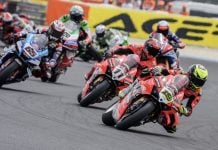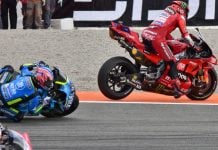Copyright 2004, Roadracing World Publishing, Inc.
FIRST PERSON/OPINION:
(Although, frankly, he’s probably wasting his time, because AMA Pro Racing did not ask for comment on its already-made decision regarding class structure, instead simply allowing comment on rules regarding that already-determined class structure. Now, on to Marcello’s thoughts.)
Dear Rule Makers,
In reviewing the April 24th AMA Pro Racing press release regarding the 2004 class structure, I wish to add my comment to a sport I love dearly, and suggest a 125 Grand Prix class. I imagine a 125 class must have been overlooked in the decision making process. I say that only because I noticed two Supersport classes, and no more Grand Prix class for the future of AMA racing. If anybody had presented a strong argument for a 125 Grand Prix replacement for 250s, surely logic would prevail. Mr. Hollingsworth said, “The task of developing an all-new class structure is an extraordinarily complex process and it is impossible to satisfy everyone.”
The complexity that he refers to is the manufacturers primary focus to sell bikes, and the sanctioning body’s goal to promote the sport. There in lies the conflict of interest. Twice in this press release the importance of pleasing fans was mentioned. Two supersport classes do not indicate this line of thinking was adhered to. If you wish to follow NASCAR’s great example of success, you will have to exclude (to an extent) the manufacturers from the decision making process. If the sport is going to expand accordingly, every rider needs to be a hero. Why? Because a grid of 36 heroes can garner a larger fan base, than six different street bikes to choose from.
In order to get things all lined up and flowing for the AMA, the class structure must become stabilized. It has to become something that won’t change for the next five years and fans can follow. It needs an entry-level class for young up coming talent so fans can follow the making of a Nicky Hayden, or John Hopkins. Hence a 125 Grand Prix class seems to be screaming at the AMA for a 250 replacement class. It exists on the world scene. It won’t be going anywhere soon, and it is the safest most maniacal entry-level class you will find.
If a Pro AMA125 class had existed, the American road racing spectator could have watched Nicky Hayden, Tommy Hayden, Kurtis Roberts, and John Hopkins, while they honed their race craft as youngsters.
I won’t go into all the benefits of learning how to road race on a real grand prix bike. A 125 (when ridden properly) will go through a corner faster than anything else on the track. After you ride a 125 everything feels like slow motion in the corner. If you crash you are closer to the ground. If the bike lands on you, it only weighs 150 pounds. It seems like the logical solution, especially for relatively safer (reducing the liability of putting teenagers on heavy 600’s) entry-level pro-am class for young riders.
How do you do it? Combine a 125-250 class until the 250’s are phased out of the Moto GP in 2006. It makes the most sense since entry speeds, and cornering speeds are close enough. Call it Extreme Lites.
If you must have two stock classes, combine them.
Sincerly,
Marcello A. del Giudice
“The Man In Black”
Las Vegas, Nevada
Marcello Weighs In On Proposed New AMA Formula Xtreme Class
Marcello Weighs In On Proposed New AMA Formula Xtreme Class
© 2003, Roadracing World Publishing, Inc.






